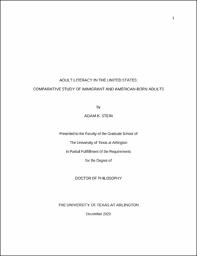
ATTENTION: The works hosted here are being migrated to a new repository that will consolidate resources, improve discoverability, and better show UTA's research impact on the global community. We will update authors as the migration progresses. Please see MavMatrix for more information.
Show simple item record
| dc.contributor.advisor | Trache, Maria | |
| dc.creator | Stein, Adam Keith | |
| dc.date.accessioned | 2020-12-22T20:35:58Z | |
| dc.date.available | 2020-12-22T20:35:58Z | |
| dc.date.created | 2020-12 | |
| dc.date.issued | 2020-12-07 | |
| dc.date.submitted | December 2020 | |
| dc.identifier.uri | http://hdl.handle.net/10106/29645 | |
| dc.description.abstract | Despite its status as a wealthy, developed nation, the United States is plagued by widespread deficiencies in adult literacy. The problem is quite severe among individuals who were born in country, yet the situation for the nation’s immigrant population is nothing short of alarming. Using the U.S. portion of the data set for the international 2012/2014 Program for the International Assessment of Adult Competencies (PIAAC), the study explores the impact of everyday practice on the development of literacy skills among adults aged 16 to 74.
Where other studies typically focus on the literacy crisis among America’s school-age children, the present study goes further by recognizing the fact that low literacy extends into adulthood. For immigrants in the U.S., the problem is often compounded by underdeveloped English-language skills and/or a lack of formal schooling. The present study provides a comparative analysis of the literacy levels and literacy practices of American-born and immigrant adults in the United States. Moreover, the two groups are compared in terms of certain sociodemographic features, including age and gender composition as well as level of education.
The study suggests that immigrants’ literacy struggles can largely be attributed to language barriers and a lack of formal schooling, with nearly 25% of adult immigrants not having completed high school. Additionally, female participants demonstrated lower literacy levels, while younger adults scored on average higher on the literacy assessment.
Of the study’s most significant findings, insight into the notion of how practice in a field contributes to acquisition of capital (Bourdieu, 1990, 1993), specifically language capital with respect to literacy, was underscored as certain literacy acts, such as reading and writing letters, were determined to have a positive impact on adult literacy scores. The study also found variation in specific methods of practice which further affected literacy levels among American-born and immigrant adults.
In closing, the study recommends legislative change at the federal level to promote consistent literacy development beginning with the nation’s youngest learners. Furthermore, transformative curriculum interventions are necessary in adult education programs to accommodate the unique needs of low literacy adults, as informed by the study’s results. An entirely different instructional framework must also be considered for low literacy immigrants who also struggle with the English language and possibly literacy in their first language. | |
| dc.format.mimetype | application/pdf | |
| dc.language.iso | en_US | |
| dc.subject | Adult literacy | |
| dc.subject | Immigrants | |
| dc.subject | American-born adult | |
| dc.subject | United States | |
| dc.title | ADULT LITERACY IN THE UNITED STATES: COMPARATIVE STUDY OF IMMIGRANT AND AMERICAN-BORN ADULTS | |
| dc.type | Thesis | |
| dc.contributor.committeeMember | Zhang, Yi | |
| dc.degree.department | Educational Leadership and Policy Studies | |
| dc.degree.name | Doctor of Philosophy in Educational Leadership and Policy Studies | |
| dc.date.updated | 2020-12-22T20:36:06Z | |
| thesis.degree.department | Educational Leadership and Policy Studies | |
| thesis.degree.grantor | The University of Texas at Arlington | |
| thesis.degree.level | Doctoral | |
| thesis.degree.name | Doctor of Philosophy in Educational Leadership and Policy Studies | |
| dc.type.material | text | |
| dc.creator.orcid | 0000-0001-9811-7589 | |
Files in this item
- Name:
- STEIN-DISSERTATION-2020.pdf
- Size:
- 727.5Kb
- Format:
- PDF
This item appears in the following Collection(s)
Show simple item record


